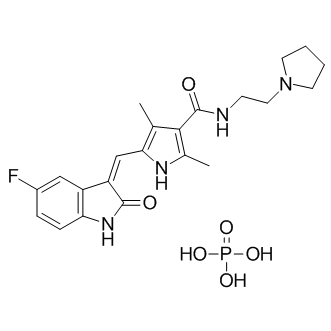| Cas No.: | 874819-74-6 |
| Chemical Name: | Toceranib phosphate |
| Synonyms: | PHA-291639; PHA291639; PHA 291639; SU-11654; SU 11654; SU11654; Toceranib; Toceranib phosphate; Brand name: Palladia. |
| SMILES: | N1C(/C=C2/C3=C(NC/2=O)C=CC(F)=C3)=C(C)C(C(NCCN2CCCC2)=O)=C1C.P(O)(O)(O)=O |
| Formula: | C22H28FN4O6P |
| M.Wt: | 494.46 |
| Sotrage: | 2 years -20°C Powder, 2 weeks 4°C in DMSO, 6 months -80°C in DMSO |
| Description: | Toceranib phosphate is a multitargeted indolinone receptor tyrosine kinase (RTK) inhibitor with Kis of 5 and 6 nM for PDGFRβ and Flk-1/KDR, respectively. |
| In Vivo: | Administration of Toceranib significantly decreases the number and percentage of Treg in the peripheral blood of dogs with cancer. Dogs receiving Toceranib and cyclophosphamide (CYC) demonstrate a significant increase in serum concentrations of IFN-γ, which is inversely correlated with Treg numbers after 6 weeks of combination treatment[3]. |
| In Vitro: | Toceranib (SU11654) is a selective inhibitor of the tyrosine kinase activity of several members of the split kinase RTK family, including PDGFR and Flk-1/KDR, with Kis of 5 and 6 nM, respectively[1]. To explore mechanisms of acquired Toceranib (TOC) resistance in canine MCT, three resistant sublines are generated from the Toceranib-sensitive exon 11 ITD c-kit mutant C2 cell line designated TR1, TR2, and TR3. Growth of the parental C2 cells is inhibited by Toceranib in a dose-dependent manner with an IC50 of <10 nM. In contrast, TR1, TR2, and TR3 sublines are resistant to inhibition by Toceranib (IC50> 1,000 nM). Sensitivity to three other KIT RTK inhibitors is similar to the observed resistance to Toceranib. The parental line as well as all three sublines retains sensitivity to the cytotoxic agents vinblastine (VBL) and CCNU. Following 72 hr culture in the presence of increasing concentrations of Toceranib, treatment naïve, parental C2 cells detach from the culture flask and become rounded, shrunken, and clumped with increased exposure to Toceranib. In contrast, Toceranib-induced morphologic differences are not identified in the resistant sublines[2]. |

 DC Chemicals' products qualify for U.S. tariff exemptions. We guarantee no price increases due to customs duties and maintain stable supply, continuing to deliver reliable research solutions to our American clients.
DC Chemicals' products qualify for U.S. tariff exemptions. We guarantee no price increases due to customs duties and maintain stable supply, continuing to deliver reliable research solutions to our American clients.





















